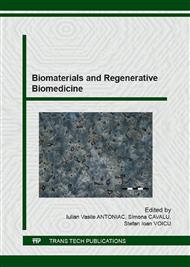p.200
p.205
p.215
p.222
p.231
p.236
p.243
p.247
p.252
Experimental Evaluation of Biocompatibility in Case of Acrylic Materials by Bio-Testing on Lab Animals
Abstract:
A bio material is a inert and non-viable material with a natural or synthetic origin that comes in to contact with tissues, blood or biological fluids, being used in prosthetic, therapeutic and storage applications, without affecting in any way living organism or their components.Biological systems may produce the deterioration of materials, process known as bio-degradation. In case of oral environment this also includes the dissolution in saliva, chemical and physical degradation, abrasion and erosion caused by the diet components, mastication process and bacteria actions. Most of the materials used in dental therapy may be toxic or may produce allergies until they bind.We evaluated during our experiment the biological consequences (bio-compatibility) that subcutaneous implanting of small acrylic dental fragments have upon tissues in case of white lab mice, keeping an eye on the local tissues reactions. The evaluation of dental materials is made by testing the bio-compatibility. Biologically tests are performed in vivo and in vitro strictly in the lab and on animals.For our experiment we used 20 white mice Wistar line, 8-9 weeks old males, 40 grams, divided in 3 groups; all of them received an acrylic implant. The experiment was centered on the observation of some physiological or pathological effects, local or systemic, that implants may have produced effects that show a toxic answer or the rejection of the material.All experimens was performed in compliance with (European Communities Council Directive 1986 (86/609/EEC) and Ordinance No. 37 of Romanian Government from 2nd February 2002.Materials bio-compatibility was highlighted by anatomic-pathological exams during which we noticed all the modifications at dermis level during the entire period. We observed the phenomenon that occurred around the implants at different time periods, than we collected samples.The data obtained at the end of our experiment allow us to sustain that acrylic materials used in dental implants have all the properties required to be considered as bio-compatible.
Info:
Periodical:
Pages:
231-235
Citation:
Online since:
May 2016
Keywords:
Price:
Сopyright:
© 2016 Trans Tech Publications Ltd. All Rights Reserved
Share:
Citation:


